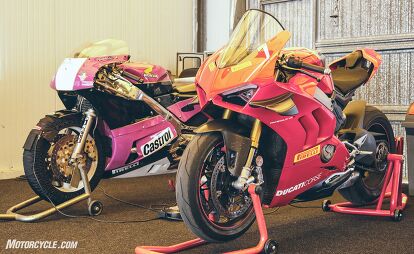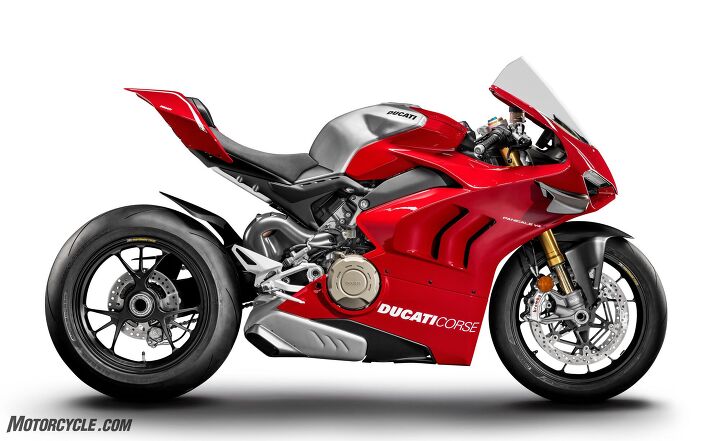Honda RC30 and Ducati V4R: State-Of-The-Art 30 Years Apart
The fourth and final installment of the Sicilian Love Affair Series
Everyone reading this had one particular motorbike they drooled over as a child.
For me, it started with the all-metal orange-tanked 1977 Kawasaki KD80 two-stroke dirt bike, followed by a white 1979 Yamaha DT100. These were the days of longing, need, and hopeless, waiting-to-get-old-enough to have the opportunity to reveal the mysteries which were these unobtainables.
I was not one of these lucky kids born on a ranch riddled with drivable lawn mowers and rusted pickup trucks with shredded bias-ply tires. I was stuck in a lower-middle-class suburban neighborhood with parents who, after every Christmas and birthday, could only repeat their infuriating mantra, “There’s nowhere to ride a dirt bike around here, and no one for you to go with. I’m sorry.”
Fast-forward to 1989; I spent every spare moment finding my way to the local Honda shop, which had a Honda RC30 on display up in their window. Only the biggest dealerships in California got one each, and I was told that despite the RC30’s ultra-high price for the day, there was an active lottery; buyers had to place their names into a hat for the chance and privilege to pay full retail price, plus a premium, to take one of these incredibly advanced and downright beautiful – Made In Japan – machines, home.
There had never been a motorcycle like this sold to the public before. It had a “diamond” type chassis (so-named like a precious stone set in jewelry), twin-spar frame that resembled a top Grand Prix racer of the day.
The newly founded 1988 production-based World Superbike series allowed for homologated “specials” to be made by manufacturers in limited numbers – as long as a required minimum was made available to the public. In all, only 3000 total units of the Honda RC30 were ever sold globally over a roughly three year period. In contrast, mainstream go-to street bikes like Kawasaki Ninja 650s and Suzuki SV650s can sell tens of thousands of units per year, globally, and for many years to come.
Looking carefully over an RC30 in the window of a dealership as a young man was nothing short of peering into a portal of quality that I had not yet experienced. The welds of the frame, the foam around the tach. The handmade aluminum tank, the selfish solo seat made from light fiberglass. Of course, I couldn’t see the internals – the titanium rods, gear driven cams, tall first gear, and slipper clutch, but you could feel that they were there.
How could a world exist so far from me, and yet so made for me?
I thought to myself, “If only someday I could arrive at a place that sees me throwing a leg over such a precious thing, maybe other areas of my life would follow suit.”
Somewhat immersed in the daydream of being surrounded by such excellence but without the means to obtain it, I bought the next best thing.
Quick story: My first year attending a four-year university I received a notice from VISA that as a student I was pre-approved for a Gold Credit Card with a $5000 spending limit. I had zero credit history at the time. I signed up for it, and the day after I got the card in the mail, I went to the local Honda dealership and bought a used 1986 red/white/blue VFR750F “Fred Merkel Special” on the credit card, at 20% interest. Best day of my life.
Okay, it wasn’t an RC30 but it was my RC30. Almost.
Fast-foward another thirty years, and I find myself in Southern Sicily about to test all of the latest liter bikes for Motorcycle.com. (See Seven Liter-Bikes That Left Me Weak In The Knee Pucks, plus also Pirelli Diablo Supercorsa Tire Range and Pirelli Angel GT II Tire Review)
While changing into some street gear inside of Pirelli’s secret warehouse full of testing bikes, I noticed an RC30 race bike propped up on display inside one of the hallways. It was immaculate, and painted in the black/purple/white color livery of the old Rumi Honda squad, which Fred Merkel had won his 1988 and 1989 World Superbike Championships with.
Later on, I mentioned to my friend at Pirelli, Salvo Pennisi, the head of tire development there, “Nice bike you’ve got there in the hallway. It’s in great condition.”
Salvo replies in a strong Italian accent, “Ah yes. This was my own bike many years ago, but Rumi need for backup for Raymond Roche, so I give happily.”
The bike is a fully-kitted HRC Honda Factory RC30.
“How cool!” I answered. “It’s always been my dream bike, actually, like for so many others. Never got to ride one, though. I did get to race a 1991 ZX-7RR and 1986 FZ750 at the Isle of Man Classic TT, also a Suzuki XR69 at the Phillip Island Classic, but never got to ride an RC30. I’m cool with it.”
“You want to ride?” Salvo says to me with a straight face. “I think it runs, I have my guys change the oil and put new tires on it, we ride at track tomorrow with other bikes.”
A pause.
“No no no, thank you. No. I’m not riding your priceless irreplaceable collectors item, not going to happen. What if something happens?” I said.
“Bah, let’s pull the old girl out, it’s been a really long time. I used to race this bike myself, you know. I did the World Superbike round at Pergusa in 1988 as a wild card, on this very bike. Would be nice to hear it running again. You should ride!”
Dude.
“Um, listen, Salvo, bubby, if it would be fun for you to have me ride your old flame, then it would be an honor.”
I was thinking to myself how I am fully capable of riding a motorcycle around a racetrack within a good margin of error, and there is no reason why I should crash anything. Not even Salvo’s trophy bike. Right?
We quietly went on with our street ride/test of the new Pirelli Angel GTs, all the while I tried to put the thought of riding an RC30 out of my head. “Miller, you’re old as dirt now – not your first rodeo. The chances of this coming off are remote, and this is okay. DO NOT GET YOUR HOPES UP. It ain’t going to happen. (The plugs will foul, or the carbs will be full of gunk, or the oil seal around the crank will have hardened, or or or or…”
We went about our business testing the street tires, then later that night Salvo says to me over dinner, “It looks good to ride the RC30 tomorrow at the track.”
I reply calmly, “Uh huh. Cool. Yeah. Great.”
To humor the situation and possibly give a little weight towards The Universe wishing this upon us, I add, “Ya know, Salvo. You wanted me to ride the new Ducati V4R winglet bike tomorrow, as well. Both the Honda and the Ducati are V4’s, both are at the top of their games when new, and both were homologated especially to win in World Superbike. If all goes to plan, maybe it’d be clever for us to concoct a little RC30 vs V4R thing, thirty years apart, for the magazine?”
He gave it a think, then his face lit up, “Good idea!”
So, we arrive at the ultra-fast Pergusa racetrack and I get to work evaluating all the top liter-bikes of 2019, back to back.
During lunchtime, I haplessly wander into an adjacent pit garage and lo and behold there sits the Rumi Honda RC30 on stands next to a $50,000 Ducati V4R — both bikes fueled up with tire warmers plugged in.
Pause.
I stare.
Really.
Really?
“Your job right now is to finish your antipasto. Don’t get your hopes up, classic bikes seldom work as we’d like them to.”
Copy that.
After lunch I continue onward with the military regimen of testing and evaluating all the latest and greatest bikes of our time.
Nearing the end of the day, very sweaty in my leathers, Salvo approaches me and says, “We can go now, I think, V4.”
I smile genuinely to his face, then more skeptically to his back as we walk to the adjacent garage.
“So Mark-uh,” he says. “I tell you what. Let me take the bike out first to make sure it’s running right, scrub in the tires, then I come give to you. Okay?”
“Absolutely.”
“I do two laps,” Salvo says.
“Have fun.”
Salvo, who’s over 60 years old now, shared with me that motorbikes have saved his life after a long and interesting career as a paratrooper in the Italian military, followed by successful achievements at breaking records riding motorcycles to some of the highest altitudes on earth.
At this moment, he gets pushed down pit lane to bump start his trusted Rumi RC30. It doesn’t fire.
One young man turns into two, which turns into three, all pushing the 1989 Honda back to life, like performing CPR.
They stop.
I watch from a quarter mile away as they fiddle with something on the bike. I could see they were all out of breath.
I don’t move, and I don’t hold my helmet in hand. But it’s not over.
They give Salvo another push and it instantly lights up. He and his RC30 enter the race track.
Now, I’m getting excited.
I recall vividly that I felt something we feel only a few times in our lives: total anticipation.
I grab my helmet and thrust it onto my head, “Two laps. Two laps. This just might happen.”
Salvo goes flying by the start/finish line engrossed in a sound that you have to hear to fully understand. It’s analog, it’s pure, it’s rare, and it’s beautiful. The sound of the V4 Honda with carburetors just brings you back, like a time machine, of FZR600s, air-cooled GSXR-1100s, ZX-7s, and Honda CBR600F2s. But this is the mack-daddy of all `80s machinery. This is the voice of it’s designer, Soichiro Honda, who said at the outset of producing the RC30, “This is what we are capable of making, cost be damned.”
Salvo came around for his second lap, then a third, then a fourth, then a fifth.
I’m actually getting more stoked with Salvo’s each passing lap, “He’s enjoying himself, go, go, go!”
After seven laps Salvo and the RC30 return to the pits. He comes to a stop in front of me, and lifts his visor. Tears are streaming down his face.
“Incredible. Incredible,” he says.
I pat him on the back heartily, and it was a special moment. I hope I can make it to his age and feel what he felt in that moment.
“Okay, now get the fuck off, before this thing breaks,” I think to myself.
Salvo steps off his former RC30 race bike and hands it to me.
I throw my leg over it, and one of his helpers then kneels down to each wheel to check the tire pressures. Water starts to pour out of its radiator as I lightly blip the throttle to keep the engine running.
With a puddle of steaming hot radiator fluid growing larger beneath the bike, Salvo tells me, “The jetting is not perfect but…”
“Got it!” I said. I put the bike in gear, and released the clutch.
I pulled away down the pit lane and entered the track.
“Not yet. Not yet. I haven’t quite… quite… ridden an RC30… quite yet,” I’m saying to myself.
First corner, second corner, third corner, and onto my knee.
Inside my helmet, “I’ve done it! I’ve done it!”
Oh, boy, what a dream is the handling of this bike. Compact, nimble, solid, definitely Grand Prix geometry but with the more sophisticated four-stroke powerplant of its time.
The RC30 fell into the corners effortlessly. The brakes were strong, the gearbox was like butter, the engine peaky. I hit the long back straight for the first time and shifted manually for the first time in days; no auto-blip up-shifts or downshifts. No electronic aids, no wheelie control, no fuel injection.
With respect, I revved it a little higher and higher. Far below redline, the motor started to sing. Through the high chicanes, the RC30 felt like a TZ250: light, planted, gobs of feel and traction. I couldn’t believe it.
“Oh, and it works, too?”
Baby, this was the highlight of my two-wheeled life. Thirty years after studying this bike in the local dealership for hours as a teenager, I finally get to know.
Have I arrived to a better place now?
Next up, was the $50,000 2019 Ducati V4R.
Homologated in small numbers to take on the World Superbike Championship, Ducati came out of the gate with a 1000cc version of its 1100cc street “S” model and, early on, dominated the series.
Withholding a full evaluation, the new V4R engine revs past 16,000 rpm with ease, the chassis is remarkable, the newest oversized Pirelli slicks stuck like glue, and the onboard electronic rider aides kept it all in check.
Not unlike a Moto2 rider coming up to MotoGP for his first test, it would take days to learn the limits of the newest Ducati in anger. The thing is mind-warping fast and remarkable in every other way you’d need it to be: brakes, chassis, aerodynamics, and winglets that definitely work at high speed and under braking to help keep the bike stable.
In conclusion, road racing motorcycles have advanced in unimaginable ways over the past thirty years. I can remember the old fantasy of, “Man, if I could only take this stock XYZ sport bike back in time ten years, I could win every race against their modern full-fledged race bikes.” And it would be true. Progress in this sport is not only measurable, it’s profound.
And we never think it could get much better than it is today, “In thirty years from now, there’s no way we could find many more improvements over now.” And yet, we always do.
But I’ve learned something today. Life is not only about the ultimate achievements in a fleeting moment, but also a longer burn where you have things and mysteries to unravel in your own time, to turn over those rocks that maybe we weren’t ready for yet. It’s nice to have those things that elude us, it just gives us something to keep striving for. Who wants to have it all in one day? The rest of our lives would be boring.
But I don’t know everything.
Mark Miller
More by Mark Miller
















































Comments
Join the conversation
Sigh. I got within minutes of buying one of these and for reasons I still can’t work out backed away. I did eventually have an RC51 but it isn’t really the same thing.
Thanks for this excellent story. My motorcycling dream is for Honda to get back to affordable V engine sportbikes. No more CBs... bring back the VFs and VFRs